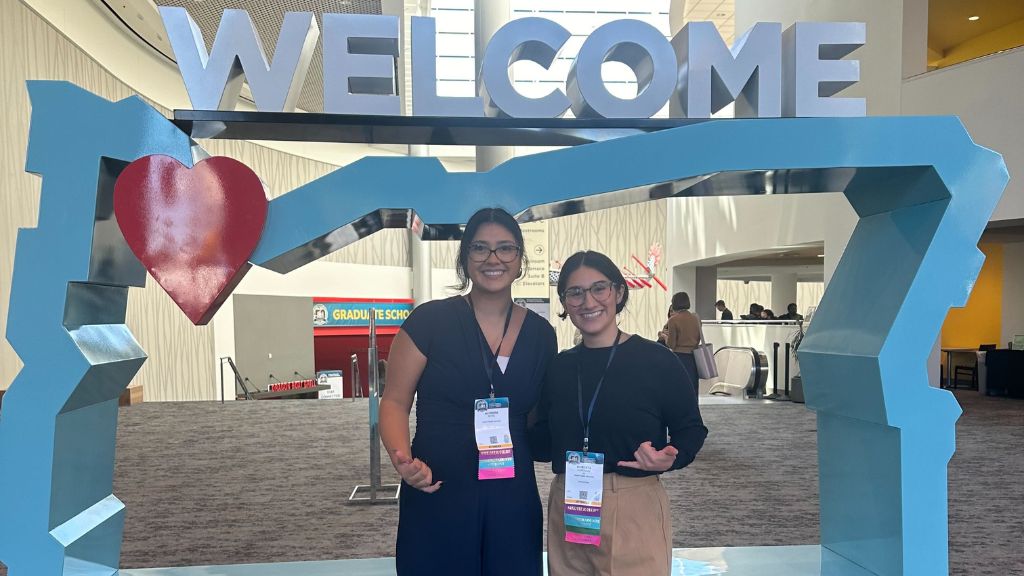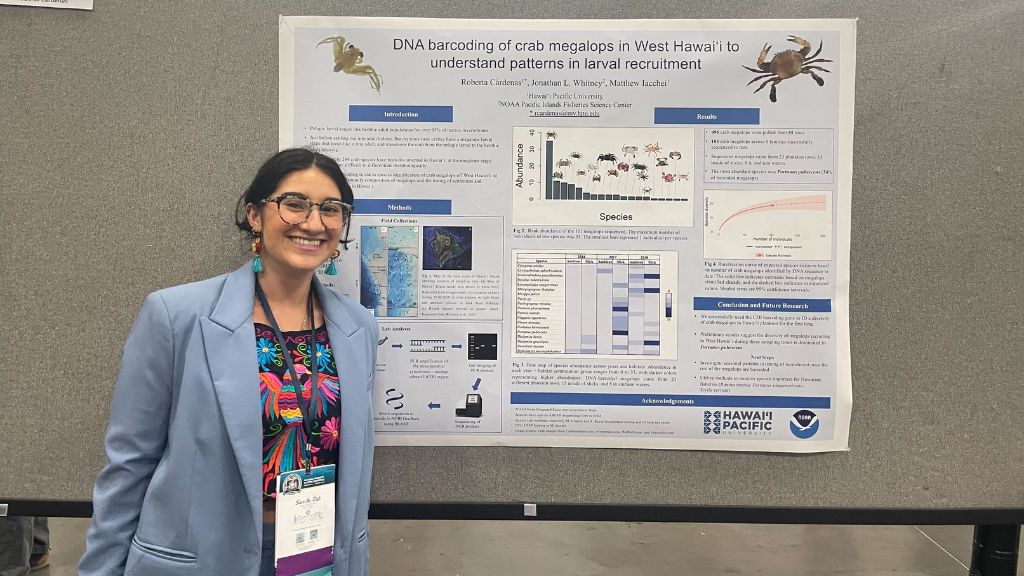Students and faculty from Hawaiʻi Pacific University (HPU) made waves at the recent Society for Advancing Chicanos/Hispanics and Native Americans in Science (SACNAS) Conference, now known as the National Diversity in STEM (NiDSTEM) conference, held in Portland, Oregon. Among the attendees were HPU Assistant Professor of Marine Science Matthew Iacchei, Ph.D., undergraduate marine biology major Alondra Reyes, and HPU alumna Roberta Cardenas (B.S. Marine Biology ʻ23), who showcased their research and contributions to the diverse landscape of STEM disciplines.
SACNAS, now NiDSTEM, is a premier event that brings together scientists, researchers, and students from various backgrounds in the fields of Science, Technology, Engineering, and Mathematics (STEM). It also attracts recruiters from government agencies, industry leaders, and academia who are seeking the brightest minds for their organizations. Iacchei emphasized the conferenceʻs importance for marine biology students like Reyes and Cardenas as a unique opportunity to showcase their research and build connections with professionals and potential mentors.
“It is much bigger than marine biology. It is a fantastic opportunity for our students to network and show the great work they are doing. The other benefit is students are able to meet so many people from all different backgrounds who are currently at all different career stages across many STEM fields, so they find role models who have had similar life experiences, and the students know that they too can attain that type of position in the future.”
Collaboration with NOAA Pacific Island Fisheries Science Center
Cardenas presented a poster from her senior capstone project, highlighting the ongoing collaboration between HPU and the NOAA Pacific Island Fisheries Science Center. The collaboration, led by research ecologist Jonathan Whitney, Ph.D., focuses on plankton sampling off the Kona Coast of Hawaiʻi, and aims to understand the larval stage of marine organisms.
“My project focused on using DNA barcoding to aid in species identification of crab megalops in West Hawaiʻi. The megalops stage occurs right before the crabs settle into their habitat, but they are difficult to identify solely using morphological features, so we used DNA barcoding to identify the species. As we continue to ID the crabs, we’re hoping to identify potential seasonal patterns in recruitment,” she explained.
This research stems from Iacchei and Whitneyʻs longstanding friendship and their shared interest in larval ecology paved the way for this partnership, resulting in valuable research on marine invertebrates. It also highlights the strong relationships that exist between Hawaiʻi's academic and scientific communities, which benefits not only research professionals but also students who participate in these types of projects.
“Working with students in the field or in the lab is one of the most fulfilling parts of our jobs as HPU professors,” said Iacchei. “I love seeing their excitement about new discoveries they are making, the ‘aha’ moments they have when they figure out a new technique or have a deeper understanding about their work and watching them grow as scientists and as people. Our most important work is helping the next generation find their path to making a positive impact on the world.”
Impact of Undergraduate Research
For Reyes and Cardenas, seizing an opportunity to participate in research while students at HPU has had a significant impact on them both personally and professionally.
Reyes is currently working on her senior capstone project but her contributions to Iacchei’s marine biology research laboratory began over two years ago when she assisted on a graduate thesis project about invasive mullets. Since then, she’s worked on two other senior capstone projects including Cardenas’s megalop barcoding initiative.
“I hope that these research opportunities will help me broaden my interests and hopefully open more doors for other fields in marine biology,” Reyes said.
Cardenas shared a similar experience in the lab, first assisting on senior capstone research projects before embarking on her own. But the greatest influence that research had on her academically and professionally was in relation to her network.
“Attending the conference allowed me to speak to researchers across a variety of fields, specifically in polar science, which is what I want to pursue in the future. It was nice to get some insight into potential research opportunities and methodologies being used to investigate climate change,” she explained.
Cardenas also connected with a graduate school advisor at the conference and plans to pursue a Ph.D. She recently submitted her applications to some of the country’s top programs and is excited to dive deeper into topics that impact marine life on a global scale.
“I want to research cold environments in the future,” she said. “I earned my PADI Divemaster certification when I was 18 and I recently earned my scientific diving certification. I’ll be participating in a scientific diving course in Sitka, Alaska in the spring. It will be my first time diving outside of the tropics, so it’ll be interesting to dive in a dry suit for the first time and see the different wildlife.”
Committed to Excellence
Hawaiʻi Pacific University's presence at the SACNAS Conference underscores the institutionʻs commitment to fostering diversity and excellence in the marine biology and STEM fields. The achievements of professor Iacchei, Alondra Reyes, and Roberta Cardenas serve as an inspiration for aspiring scientists and highlight the significance of undergraduate research opportunities in shaping the future of marine biology.
“Each student learns differently, so it’s important for students to try out all kinds of experiences and approaches to learn about the world around them from different perspectives,” Iacchei said. “I think many students learn best by doing, so hands-on experience helps students to better understand and see the application of what we are teaching in the classroom. It can motivate the students to want to learn about certain topics to help their research and start a positive reinforcement cycle where they are excited to keep learning and answer the questions they are interested in. This process also helps students figure out what they really enjoy – and do not enjoy – doing on a day-to-day basis which can help them find the best career path after graduation.”




